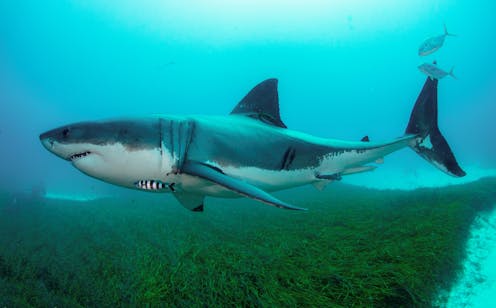The real reason to worry about sharks in Australian waters this summer: 1 in 8 are endangered
- Written by Peter Kyne, Senior Research Fellow in conservation biology, Charles Darwin University

If you’re heading to the beach this summer, the thought of sharks might cross your mind. I don’t mean wondering whether a shark will take you for dinner (that’s very, very unlikely) but rather, how these remarkable creatures are faring in the marine ecosystem.
I recently led the first complete assessment of all species of sharks, rays and ghost sharks in Australian waters. My team and I found while most species are secure, about 12%, or 39 species, are threatened with extinction.
No country has a higher diversity of sharks than Australia. That means we have a special responsibility to protect them from threats such as fishing and damage to their marine habitat.
To prevent shark extinctions on our watch, Australia must invest far more heavily to close vast knowledge gaps and ensure threatened species are protected and recovered.
Ancient ocean dwellers
Sharks are an ancient lineage of fishes that have roamed the oceans for around 450 million years. They occupy tropical, temperate and polar marine waters, while a small number have adapted to live in freshwater.
Sharks and their relatives, rays and ghost sharks, are known as cartilaginous fishes. Some 328 of the world’s cartilaginous fishes – comprising one-quarter of the world’s total – occur in Australian waters, including the sub-Antarctic and Antarctic waters. Of these, 138 are found nowhere else on Earth.
Globally, sharks face a dire conservation crisis. About 32% of species are threatened with extinction and less than half are assessed as “Least Concern” (not at risk of extinction).
The main threats around the world are overfishing combined with inadequate management such as a lack of fishing regulations, weak protections for threatened species and poor implementation of international agreements.
Australia’s relatively better position is a result of a long history of ocean policy and fisheries management. Australia also has extensive areas with only limited or no fishing pressure as well as a representative network of marine parks.
But some regions, particularly waters off Australia’s southeast, have experienced high levels of fishing pressure which threaten some species.
Other threats to sharks in Australian waters include shark control measures in some states, habitat degradation, aquaculture and climate change.
Read more: New documentary recalls how Valerie Taylor played with sharks to prove a point
What the research found
The research I led examined the national status of Australian sharks.
The news is a lot brighter than the global situation. Of all sharks occurring in Australian waters, 70% were assessed as “Least Concern”.
But we identified 39 Australian shark species threatened with extinction. And worryingly, most lack the protection or conservation plans needed for their populations to recover.
For example, only nine of the species are listed as threatened under Australia’s federal environment law, the Environment Protection and Biodiversity Conservation Act.
We identified five species where the data is robust enough to pass the threatened species nomination process, and recommend federal authorities consider these species for immediate listing. They consist of:
- greeneye spurdog
- eastern angelshark
- whitefin swellshark
- narrow sawfish
- Australian longnose skate.
However, this still leaves a group of under-studied threatened species at risk of slipping through the cracks, because not enough data exists to support official listing nominations. We identified 12 species facing this predicament.
For example, we assessed three species of small rays from southeast Australia, known as stingarees, as vulnerable to extinction due to commercial fishing. The species’ decline has been recorded since the late 1990s. However, nominations to be listed as threatened under federal law will require more data, particularly contemporary catch levels and trends.
As with many other species we identified, there is currently no mechanism – or dedicated funding – in place to ensure such data is collected.
Read more: How will sharks respond to climate change? It might depend on where they grew up
How to save Australian sharks
Major investment is needed to recover Australia’s threatened sharks. Using the mean estimated cost of recovering a threatened fish species and accounting for inflation, I calculate the cost at about A$114 million each year.
The figure represents about 0.3% of the national defence budget – a benchmark against which the costs of environmental action are often compared.
More broadly, financial investment in threatened species in Australia has been shown to be inadequate.
Recent federal funding announcements include A$100 million to protect oceans and $57 million linked to the national threatened species strategy. This comes nowhere near the level of investment required.
Australia urgently needs a dedicated, adequately resourced fund with the aim of recovering and delisting threatened species. Such a fund should support the recovery planning process – in contrast to current federal government moves to scrap recovery plans for nearly 200 threatened species.
Our research is a call to action to secure all Australia’s sharks. It provides a benchmark from which changes can be measured, and hopefully will help guide management to prevent extinctions.
Read more: Poor Filipino fishermen are making millions protecting whale sharks
Authors: Peter Kyne, Senior Research Fellow in conservation biology, Charles Darwin University





